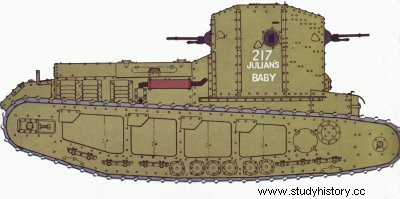
Mark A Whippet
Country Great Britain
Type
:medium tank
Performance:speed 12.8 km/h
autonomy
64 km.
Crew :3 men
Armament :4 Hotchkiss 303 machine guns.
Shielding :at least 5 mm; max 14mm.
Dimsension
:
length 6.09m;
width
:2.61m;
height :2 74m
Weight in combat order :14.2 t
Engines :two Taylor 6 cyl. in-line gasoline, water-cooled, each developing 45-hp
Service Time :Introduced in early 1918 into the British Army Received its baptism of fire in March
1918 and fought tirelessly until the end of the war. Withdrawn from service in peacetime.
The production
reached the approximate figure of 200 units. Also
used by Japan and the USSR.
Hardly the first rombdidal. the Mark I, had he demonstrated his skills that the War Office asked for a lighter and faster tank capable of fulfilling the traditional mission of the cavalry, that is to exploit a breakthrough and pursue the enemy . The principle was to give armor the place of the horse and Sir William Tritton, father of the Mark I and managing director of William Foster &Co. of Lincoln. undertook the studies leading to what he called the "Hunter Tritton", a name that speaks for itself. Land crossing capabilities were considered less important than for battle tanks since it could reasonably be assumed that the latter would have laid fascines in the largest excavations. As a result, the length of the "Hunter" could be reduced, which would also reduce the overall weight and dimensions.
The organization of the vehicle resembled that of the armored cars then in service in that the engine compartment was in the front and the driving position behind a long bonnet. Behind the driver was a pivoting turret to accommodate the tank commander and the gunner. Unfortunately the pivoting turret was abandoned on the production models. The manufacture was facilitated but the life of the crew became much more difficult because the tank commander and his gunner now found themselves in front of four machine guns to be used, within the limits of a combat room which had never been provided for this purpose. Sir William Tritton was very aware of the loss of power caused by braking on the shafts of the side reduction gears and to remedy the problem without adding to the difficulties of manufacture, he employed a motor for each track. A sound measure in theory, in practice the source of a thousand complications_ The Tritton method was taken up on a wheeled amphibious of the American navy. with comparable results, of course.
For the first time, the tracks no longer ran all around the hull, a harbinger of a complete break with tradition, and the vehicle found a resolutely modern appearance. Mud weirs did great service by permanently clearing the tracks and bogies, which made maintenance much easier. Unfortunately the bogies were not suspended, which ruled out any idea of reaching high speeds; in fact the theoretical maximum speed was only possible on terrain free of any obstacle and in the mud of Flanders, the Whippet was far inferior to the horse in terms of mobility. The range was too limited for a vehicle whose mission was to exploit a breakthrough; running out of fuel being unavoidable after 64 km. the crews resorted to desperate means, carrying additional fuel in canisters fixed to the outside of the hull, a suicidal habit in operations. As for the original tank. in front of the engine, between the frontal advances, it was protected by armor... but ideally placed to receive the anti-tank shells.
Despite these defects, and it would be easy to cite many of them Others, the Whippet was considered a complete success and the Germans hastened to copy it almost point by point while having the wisdom to want to mount a 57 mm gun in the turret. The Armistice overtook the Germans but their version was further developed in Sweden, under the designation of m-21 Bofors (of which there is still a copy) and the machine became much more effective, while the The British had abandoned it in 1919 and scrapped the 200 existing examples... not without having experimented, at the central workshop of the Tank Corps, in France, with a Whippet with finally suspended bogies. The improvement was very clear and with the adoption of a 360 hp Rolls-Royce Eagle aircraft engine taken from a Handtey Page bomber, the tank reached 48 km/h without difficulty. But all these possibilities remained unexploited and British tank doctrine remained attached to the Medium C and its derivatives.
